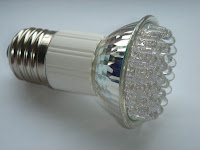Today I’ll take a look at a few current myths that persist for LED lighting.
1. LED lighting is the most efficient lighting available.
OK, I already know people will dispute this one, but please read on and see my explanation.This myth falls in the category of potential being confused with what is sold today in the big box stores and hardware chain stores.
Now, LED lighting is VERY efficient today, and in some cases, is the most efficient lighting available. And it has the potential to be even more efficient in the near future. But when you browse your local hardware store you’ll likely observe that CFLs tend to provide the most lumens per watt for most consumer household lighting. If you truly want to find those super efficient LED bulbs, you often have to thoroughly search the internet, and accept "cooler" colored LEDs.
Of course, there are trade-offs with CFLs, such as the “slow start” delay before maximum brightness is achieved, and the small amount of mercury that is used in each bulb. And this “myth” has a short shelf life – it will switch from myth to fact within a matter of months or a couple of years when LEDs clearly overtake CFLs in efficiency.
2. LED lighting is always blue colored.
This myth is based on yesterday’s capabilities being confused with inherent limitations. This is compounded by the fact that many mass marketed bulbs at Walmart and other stores continue to have blue-tinged color temperatures in the 3500 K range.
However, LED lighting can achieve “soft light” categorization today, with temperatures below 3000 kelvin (K). While some incandescent lights are in the neighborhood of 2600 K, providing a warmer hue, there are now a few mass-marketed LEDs in the 2900 to 3000 K range and some specialty LEDs at 2700 K. While 3000 K may look cooler colored than 2600 K, it is a in the range which people can easily adjust to.
3. All LED Bulbs Can Be Dimmed
This myth is just a bit of hyperbole. MOST LED bulbs can be dimmed, but do not assume they call can. Read the package label!
4. LED Lightbulbs Are Not Cost Effective
Well, this entirely depends on your application, and is certainly not true as a blanket statement. Obviously, replacing a light bulb you use 10 minutes a day with a $30 LED bulb is not very cost effective. But replacing a bulb you run 10 hours a day with a $15 bulb might be. I’ve profiled three cases where LED bulbs made sense for me – my outdoor coach lights, my landscape lights, and my daughter’s night light. Oh, and they can also be cost effective for holiday light displays, too.
As you can see, LED bulbs hold a lot of promise and in some cases can help reduce your electric bill today.
Personally, I use my payback calculator and determine if an LED bulb makes sense for a given application. I’ve exhausted my current options given the LED prices, but given the price decreases and efficiency improvements, I expect to slowly start adding more LEDs to my house in the next year or two.


I can't wait for CFLs to be a thing of the past! I think you said it before Mike - CFL is a bridge technology. LED and ESL look so much more promising. I've been considering ordering ESLs from the Vu1 website, in fact. Have you received your test bulb yet?
ReplyDeletegood
ReplyDelete